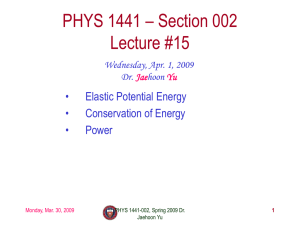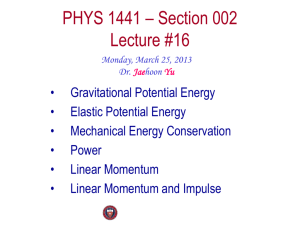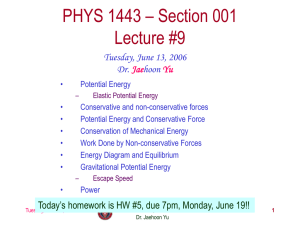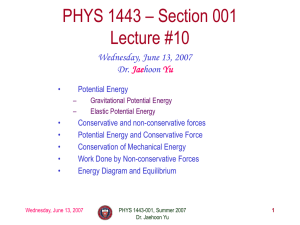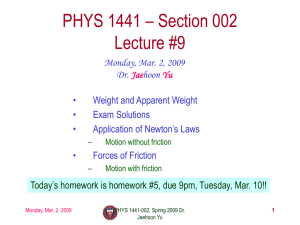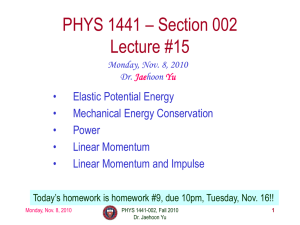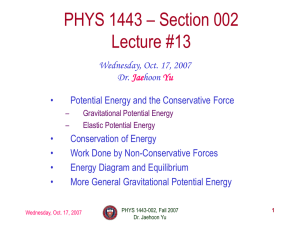Monday, March 28, 2011
advertisement
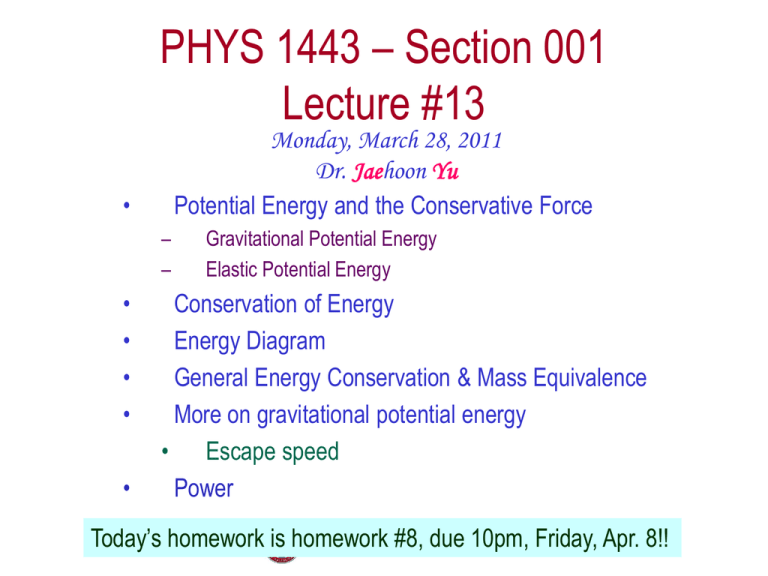
PHYS 1443 – Section 001
Lecture #13
Monday, March 28, 2011
Dr. Jaehoon Yu
Potential Energy and the Conservative Force
•
–
–
•
•
•
•
•
Gravitational Potential Energy
Elastic Potential Energy
Conservation of Energy
Energy Diagram
General Energy Conservation & Mass Equivalence
More on gravitational potential energy
• Escape speed
Power
Today’s homework is homework #8, due 10pm, Friday, Apr. 8!!
Announcements
• Quiz Wednesday, Mar. 30
– Beginning of the class
– Covers up to what we finish today
• Second non-comprehensive term exam date
– Time: 1 – 2:20pm, Wednesday, Apr. 6
– Location: SH103
– Covers: CH6.4 – what we finish Monday, Apr. 4
• Colloquium Wednesday at 4pm in SH101
• A special seminar 1:30pm, Friday, Apr. 1, Planetarium
Monday, March 28, 2011
PHYS 1443-001, Spring 2011
Dr. Jaehoon Yu
2
Monday, March 28, 2011
PHYS 1443-001, Spring 2011
Dr. Jaehoon Yu
3
Monday, March 28, 2011
PHYS 1443-001, Spring 2011
Dr. Jaehoon Yu
4
Special Project
L
θA
h{
B
m
T
m
mg
Monday, March 28, 2011
A ball of mass m is attached to a light cord of
length L, making up a pendulum. The ball is
released from rest when the cord makes an
angle θA which is greater than 90 degrees
with the vertical, and the pivoting point P is
frictionless. Find the speed of the ball when
it is at the lowest point, B. 10 points
Due: beginning of the class Monday, Apr. 11
Conservative Forces and Potential Energy
The work done on an object by a conservative force is
Wc
equal to the decrease in the potential energy of the system
What does this
statement tell you?
xf
xi
Fx dx U
The work done by a conservative force is equal to the negative
change of the potential energy associated with that force.
Only the changes in potential energy of a system is physically meaningful!!
We can rewrite the above equation
in terms of the potential energy U
xf
U U f U i x Fx dx
i
So the potential energy associated
with a conservative force at any
given position becomes
U f x Fx dx U i Potential energy
What can you tell from the
potential energy function above?
Since Ui is a constant, it only shifts the resulting
Uf(x) by a constant amount. One can always
change the initial potential so that Ui can be 0.
Monday, March 28, 2011
xf
xi
PHYS 1443-001, Spring 2011
Dr. Jaehoon Yu
function
6
More Conservative and Non-conservative Forces
The work done on an object by the gravitational force does not
depend on the object’s path in the absence of a retardation force.
N
h
When directly falls, the work done on the object by the gravitation force is
l
mg
Wg Fg incline l mg sin l
When sliding down the hill
of length l, the work is
How about if we lengthen the incline by a
factor of 2, keeping the height the same??
Wg mgh
mg l sin mgh
Still the same
amount of work
Wg mgh
So the work done by the gravitational force on an object is independent of the path of
the object’s movements. It only depends on the difference of the object’s initial and
final position in the direction of the force.
Forces like gravitational and
elastic forces are called the
conservative force
Monday, March 28, 2011
1.
2.
If the work performed by the force does not depend on the path.
If the work performed on a closed path is 0.
Total mechanical energy is conserved!!
PHYS 1443-001, Spring 2011
Dr. Jaehoon Yu
EM KEi PEi KE f PE f
7
Example for Potential Energy
A bowler drops bowling ball of mass 7kg on his toe. Choosing the floor level as y=0, estimate
the total work done on the ball by the gravitational force as the ball falls on the toe.
Let’s assume the top of the toe is 0.03m from the floor and the hand
was 0.5m above the floor.
U i mgyi 7 9.8 0.5 34.3J U f mgy f 7 9.8 0.03 2.06J
Wg U U f U i 32.24J 30J
M
b) Perform the same calculation using the top of the bowler’s head as the origin.
What has to change?
First we must re-compute the positions of the ball in his hand and on his toe.
Assuming the bowler’s height is 1.8m, the ball’s original position is –1.3m, and the toe is at –1.77m.
U i mgyi 7 9.8 1.3 89.2J U f mgy f 7 9.8 1.77 121.4J
Wg U U f U i 32.2J 30J
Monday, March 28, 2011
PHYS 1443-001, Spring 2011
Dr. Jaehoon Yu
8
Elastic Potential Energy
Potential energy given to an object by a spring or an object with
elasticity in the system that consists of an object and the spring.
The force spring exerts on an object when it is
distorted from its equilibrium by a distance x is
The work performed on the
object by the spring is
Ws
xf
xi
Fs kx
Hooke’s Law
x
f
1 2
kx dx kx 1 kx2f 1 kxi2 1 kxi2 1 kx2f
2
2
2
2
2 xi
The potential energy of this system is
1 2
U s kx
2
The work done on the object by the
spring depends only on the initial and
final position of the distorted spring.
The gravitational potential energy, Ug
Where else did you see this trend?
What do you see from
the above equations?
So what does this tell you about the elastic force?
Monday, March 28, 2011
A conservative force!!!
PHYS 1443-001, Spring 2011
Dr. Jaehoon Yu
9
Conservation of Mechanical Energy
E K U
Total mechanical energy is the sum of kinetic and potential energies
m
mg
h
Let’s consider a brick of
mass m at the height h
from the ground
The brick gains speed
What does
this mean?
U g mgh
What happens to the energy as
the brick falls to the ground?
m
h1
What is the brick’s potential energy?
xf
U U f U i x Fx dx
By how much?
i
v gt
1 2 1 22
So what?
The brick’s kinetic energy increased K mv mg t
2
2
And? The lost potential energy is converted to kinetic energy!!
The total mechanical energy of a system remains
Ei E f
constant in any isolated system of objects that
interacts only through conservative forces:
Ki U i K f
Principle of mechanical energy conservation
Monday, March 28, 2011
PHYS 1443-001, Spring 2011
Dr. Jaehoon Yu
U f
10
Example
A ball of mass m at rest is dropped from the height h above the ground. a) Neglecting air
resistance determine the speed of the ball when it is at the height y above the ground.
m
PE
KE
mgh
0
mg
h
m
mvi2/2
Using the
principle of
mechanical
energy
conservation
mgy mv2/2 mvf2/2
1
Ki U i K f U f 0 mgh mv2 mgy
2
1 2
mv mg h y
2
v 2 g h y
b) Determine the speed of the ball at y if it had initial speed vi at the
time of the release at the original height h.
y
0
Again using the
principle of mechanical
energy conservation
but with non-zero initial
kinetic energy!!!
This result look very similar to a kinematic
expression, doesn’t it? Which one is it?
Monday, March 28, 2011
Ki U i K f U f
1 2
1
mvi mgh mv 2f mgy
2
2
1
m v 2f vi2 mg h y
2
v f vi2 2 g h y
PHYS 1443-001, Spring 2011
Dr. Jaehoon Yu
11
Example
A ball of mass m is attached to a light cord of length L, making up a pendulum. The ball is
released from rest when the cord makes an angle θA with the vertical, and the pivoting point P
is frictionless. Find the speed of the ball when it is at the lowest point, B.
PE
mgh
0
KE
L
θA
h{
B
m
Compute the potential energy
at the maximum height, h.
Remember where the 0 is.
T
m
Using the principle of
mechanical energy
conservation
0
mg
mv2/2
b) Determine tension T at the point B.
Using Newton’s 2nd law
of motion and recalling
the centripetal
acceleration of a circular
motion
h L L cos A L 1 cos A
U i mgh mgL1 cos A
Ki U i K f U f
0 mgh mgL1 cos A
v 2 2 gL1 cos A v 2 gL1 cos A
v2
v2
Fr T mg mar m r m L
v2
v2
2 gL1 cos A
T mg m m g m g
L
L
L
m
Monday, March 28, 2011
1
mv 2
2
gL 2 gL1 cos A
L
Cross check the result in
a simple situation. What
happens when the initial
angle A is 0? T mg
T mg3 2 cos A
PHYS 1443-001, Spring 2011
Dr. Jaehoon Yu
12
Work Done by Non-conservative Forces
Mechanical energy of a system is not conserved when any one of the
forces in the system is a non-conservative (dissipative) force.
Two kinds of non-conservative forces:
Applied forces: Forces that are external to the system. These forces can
take away or add energy to the system. So the mechanical energy of the
system is no longer conserved.
If you were to hit a free falling ball , the force you apply to
the ball is external to the system of the ball and the Earth.
Therefore, you add kinetic energy to the ball-Earth system.
Kinetic Friction: Internal non-conservative force
that causes irreversible transformation of energy.
The friction force causes the kinetic and potential
energy to transfer to internal energy
Monday, March 28, 2011
Wyou Wg K ; Wg U
Wyou Wapplied K U
W friction K friction fk d
E E f Ei K U fk d
PHYS 1443-001, Spring 2011
Dr. Jaehoon Yu
13
Example of Non-Conservative Force
A skier starts from rest at the top of frictionless hill whose vertical height is 20.0m and the
inclination angle is 20o. Determine how far the skier can get on the snow at the bottom of the
hill when the coefficient of kinetic friction between the ski and the snow is 0.210.
Don’t we need to
know the mass?
h=20.0m
θ=20o
Compute the speed at the bottom of the
hill, using the mechanical energy
conservation on the hill before friction
starts working at the bottom
1 2
ME mgh mv
2
v 2 gh
v 2 9.8 20.0 19.8m / s
The change of kinetic energy is the same as the work done by the kinetic friction.
What does this mean in this problem?
Since we are interested in the distance the skier can get to
before stopping, the friction must do as much work as the
available kinetic energy to take it all away.
K K f K i f k d
Since K f 0 Ki f k d ; f k d Ki
f k k n k mg
1
2
mv 2
Ki
v2
19.8
2
95.2m
d
k mg
k mg 2 k g 2 0.210 9.80
Monday, March 28, 2011
Well, it turns out we don’t need to know the mass.
What does this mean?
No matter how heavy the skier is he will get as far as
anyone else has gotten starting from the same height.
PHYS 1443-001, Spring 2011
Dr. Jaehoon Yu
14
